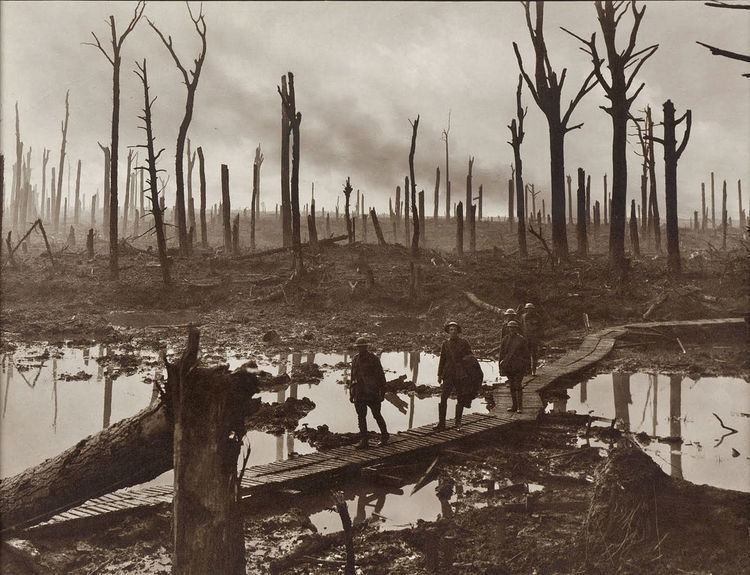Active 1916–19191921–1944 | Country Australia | |
 | ||
Engagements World War IWestern FrontWorld War IIHome Front Notablecommanders Herbert CoxWilliam HolmesEwen Sinclair-Maclagan | ||
The Australian 4th Division was formed in the First World War during the expansion of the Australian Imperial Force infantry brigades in February 1916. In addition to the experienced 4th Brigade (previously in the original New Zealand and Australian Division) were added the new 12th and 13th Brigades (spawned from the battalions of the 4th and 3rd Brigades respectively). From Egypt the division was sent to France. After the war ended and the AIF was demobilised, the division was dissolved.
Contents
- Formation
- Egypt
- Somme 1916
- Hindenburg Line
- German Spring Offensive 1918
- Commanders
- Casualties
- Inter war years
- World War II
- Units subordinated to the 4th Division in World War II
- References
In 1921, the 4th Division name was reactivated as a Citizen Military Forces (militia/reserve) formation. The division performed home defence duties for most of World War II, before deactivation in 1944.
Formation
In January 1916, Major General A. J. Godley, then commanding the Australian and New Zealand Army Corps and the AIF, put forward a proposal to use Australian reinforcements then training in Egypt to form two new divisions. The Australian government concurred and the Australian 4th Division was formed in this expansion of the Australian Imperial Force infantry brigades in February 1916. In addition to the experienced 4th Brigade (previously in the original New Zealand and Australian Division) there were added the new 12th and 13th Brigades (spawned from the battalions of the 4th and 3rd Brigades respectively).
Egypt
The 4th Division began forming in Egypt in February 1916. The new division included the 4th Infantry Brigade, 4th Field Company, 4th Field Ambulance and 7th Army Service Corps Company which had fought at Gallipoli. The 12th and 13th Infantry Brigades were formed by taking half the personnel of the 4th and 3rd Infantry Brigades. Delays in assembling the artillery meant that the Division could not depart for France before June 1916.
Somme, 1916
The division was initially stationed on the Suez Canal. In June 1916 it moved to France, taking over part of the "nursery" sector near Armentières. Its stay there was brief and soon it was accompanying the First and Second Divisions to the Somme sector. In August 1916 it relieved the Second Division on the Pozières Heights and repulsed a major German counterattack. It then drove north to the outskirts of Mouquet Farm. A second tour of the Somme at Mouquet Farm followed in September and a third at Flers in October.
Hindenburg Line
On 11 April 1917 the division assaulted the Hindenburg Line in the First Battle of Bullecourt. The battle was a disaster and 1170 Australian prisoners were taken by the Germans. In June it participated in the Battle of Messines. In September it participated in the Battle of Polygon Wood.
German Spring Offensive, 1918
In March 1918 the division was rushed to the Somme region to stem the German Offensive. The Australian 3rd and 4th Divisions had been ordered to proceed to Amiens to strengthen the retreating British 5th Army. There it repulsed the advancing Germans in hard fought battles at Hebuterne and Dernancourt. The Battle of Dernancourt involved the Australian 12th and 13th Brigades ( 4th Division ) on the railway embankment and cuttings in Dernancourt, just south of Albert. The under strength Australian Brigades ( numbering about 4,000 ) faced 4 German Divisions totalling about 25,000. Situated on the western side of the Ancre River valley, the Australians formed a defensive line at the railway embankment, from which they held back German attacks. The Australian 48th Battalion soon found itself outflanked by German to its rear. The 48th was ordered to hold at all costs but by midday was facing annihilation and the senior officer ordered a withdrawal. Much like the actions at Bullecourt the previous year, the Australian battalion withdrew successfully and in order. This action costs 12th and 13th Brigades ( 4th Division ) 1,100 casualties.
In April its 13th Infantry Brigade was involved in the counterattack at Villers-Bretonneux.On April 21, German deserters revealed that German attack preparations were nearing completion. They revealed that the attack would commence early on April 24, with the first two to three hours consisting of gas shelling. British aerial observations revealed German troops massing in trenches less than two kilometres south of Villers-Bretonneux in Hangard Wood.
On the night of April 22–23, British and Australian artillery shelled German mustering areas. At dawn the infantry was standing ready but no attack eventuated, most of the activity on this day was in air as planes from both sides criss-crossed the battlefield, bombing, strafing and engaging in dogfights. It was during one of these dogfights that the German "Red Baron" was shot down over Australian lines, north of Villers-Bretonneux at Corbie. The strongest evidence points to Australian sergeant, Cedric Popkin of the 24th Machine-Gun Company, 4th Division as firing the actual bullet that killed Baron Manfred von Richthofen.
The division went on to fight in the Battle of Hamel, Battle of Épehy (with distinction), Battle of Amiens and the Hindenburg Line, finally reaching the town of Bellenglise.
The Division was not selected to advance into Germany. Demobilisation commenced in late 1918 and in March 1919 the Division merged with 1st Australian Division.
Commanders
1916: Maj. Gen. H. V. Cox
1916-1917: Maj. Gen. W. Holmes
1917-19: Maj. Gen. Ewen Sinclair-Maclagan
Casualties
Inter war years
In 1921, the 4th Division name was revived and was assigned to an Citizen Military Forces (reserve) unit based in Melbourne, which served in Australia during World War II
World War II
After the outbreak of war with Japan, the division became part of III Corps, which was responsible for the defence of Western Australia. The division garrisoned WA until it was inactivated in November 1944.
